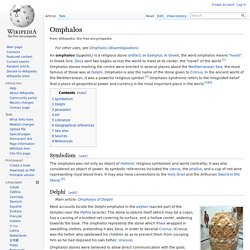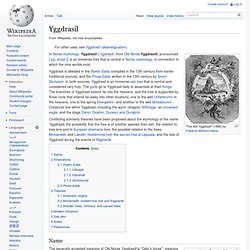

Mount Meru. Mount Meru (Sanskrit: मेरु), also called Sumeru (Sanskrit) or Sineru (Pāli) or Kangrinboqe to which is added the approbatory prefix su-, resulting in the meaning "excellent Meru" or "wonderful Meru" and Mahameru i.e.

"Great Meru" (Chinese: {{{3}}} Xumi Shan, Japanese: 須弥山 Shumi-sen, Pāli Neru, Burmese: မြင်းမိုရ် Myinmo), is a sacred mountain with five peaks[1] in Hindu, Jain as well as Buddhist cosmology and is considered to be the center of all the physical, metaphysical and spiritual universes. Many famous Hindu and similar Jain as well as Buddhist temples have been built as symbolic representations of this mountain. The highest point (the finial bud) on the pyatthat, a Burmese-style multi-tiered roof, represents Mount Meru. Geographical[edit] Some researchers identify Mount Meru or Sumeru with the Pamirs, north-east of Kashmir.[4][5][6][7][8][9][10][11][12][13] There exist several versions of Cosmology in existing Hindu texts.
Omphalos. Symbolism[edit] The omphalos was not only an object of Hellenic religious symbolism and world centrality; it was also considered an object of power.

Its symbolic references included the uterus, the phallus, and a cup of red wine representing royal blood lines. It may also have connections to the Holy Grail and the Arthurian Sword in the Stone.[5] Delphi[edit] The omphalos in museum of Delphi. Jerusalem[edit] The omphalos at the Church of the Holy Sepulchre, Jerusalem, represents, in Christian mediaeval tradition, the navel of the world (the spiritual and cosmological centre of the world).[6] Jewish tradition held that God revealed himself to His people through the Ark of the Covenant in the Temple in Jerusalem, which rested on the Foundation stone marking the centre of the world.[7] This tradition may have stemmed from the similar one at Delphi.
Art[edit] Literature[edit] ""Billy Pitt had them built," Buck Mulligan said, "when the French were on the sea but our's is the omphalos. "" Yggdrasil. In Norse mythology, Yggdrasil (/ˈɪɡdrəsɪl/; from Old Norse Yggdrasill, pronounced [ˈyɡːˌdrasilː]) is an immense tree that is central in Norse cosmology, in connection to which the nine worlds exist.

Conflicting scholarly theories have been proposed about the etymology of the name Yggdrasill, the possibility that the tree is of another species than ash, the relation to tree lore and to Eurasian shamanic lore, the possible relation to the trees Mímameiðr and Læraðr, Hoddmímis holt, the sacred tree at Uppsala, and the fate of Yggdrasil during the events of Ragnarök. Name The generally accepted meaning of Old Norse Yggdrasill is "Odin's horse", meaning "gallows". This interpretation comes about because drasill means "horse" and Ygg(r) is one of Odin's many names. The Poetic Edda poem Hávamál describes how Odin sacrificed himself by hanging from a tree, making this tree Odin's gallows.
A third interpretation, presented by F. Attestations Poetic Edda Völuspá Hávamál Grímnismál Prose Edda Theories. Axis mundi. The axis mundi (also cosmic axis, world axis, world pillar, center of the world, world tree), in certain beliefs and philosophies, is the world center, or the connection between Heaven and Earth.

As the celestial pole and geographic pole, it expresses a point of connection between sky and earth where the four compass directions meet. At this point travel and correspondence is made between higher and lower realms.[1] Communication from lower realms may ascend to higher ones and blessings from higher realms may descend to lower ones and be disseminated to all.[2] The spot functions as the omphalos (navel), the world's point of beginning.[3][4][5] Background[edit] The symbol originates in a natural and universal psychological perception: that the spot one occupies stands at "the center of the world".
This space serves as a microcosm of order because it is known and settled. Plants[edit] Plants often serve as images of the axis mundi. Human figure[edit]